In parks, on campuses, along streetscapes and in locations where sports and other gatherings take place, shelters and shade structures play major roles and serve many purposes. And while they fulfill a variety of needs, they can also make attractive and aesthetically pleasing additions to public locales, offering form as well as function and attracting users to these spaces.
“Open air structures provide protection to people and animals from the harsh outdoor elements including heat, rain, snow and most importantly, overexposure to the sun,” said Jennifer Graves, marketing supervisor for a Holland, Mich.-based company that designs, engineers and manufactures open air structures. “Structures can create a visual harmony and balance with surrounding architectural elements or stand out as an eye-catching first impression.”
Shade is very important in park settings and will extend a visitor’s stay significantly, according to Eric Hornig, senior principal with Hitchcock Design. “We like to see a combination of natural and manmade shade, and develop our solutions based on the overall style of the site design, local context, longevity of the product, cost and maintenance resource considerations of the owner.”
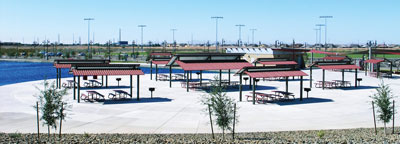
Added Lacey Lawrence, principal at Hitchcock, “Shelters also provide spaces for gathering and special event functions like family picnics, weddings, performances, programming, sporting events/team prep areas, tech pavilions for flex work, accessible spectating areas, etc.”
Pavilions are no longer limited by “standard designs,” according to Graves, who said the structures are designed and engineered for each specific site, starting with the needs and ideas of the park. “Whether it’s a large picnic pavilion or a small seating area along a walkway, parks are able to create a design as unique as their facility and community. Perfect for hosting reunions, birthday parties or just a picnic during a family outing, pavilions are one of the most essential pieces of any park area.
“Clients often have a vision and sketches that they provide our design and engineering teams,” continued Graves, who said it’s common to work directly with landscape architects to bring these visions to life. Clients can collaborate directly with the design professionals, and “Our in-house engineering team is able to provide structural calculations and drawings that are signed, sealed and ready for the permitting process, saving time and additional costs.”
Eric Pelak is the general manager of a Holland, Mich.-based company that designs and manufactures steel-framed building systems with a focus on recreational structures, and Tom Covington is the engineering manager. They said the design process typically starts by coordinating with the client and a landscape architect. “Usually, clients have a general design in mind. That design starts the collaborative process of aligning their design goals with our engineering and manufacturing capabilities.”
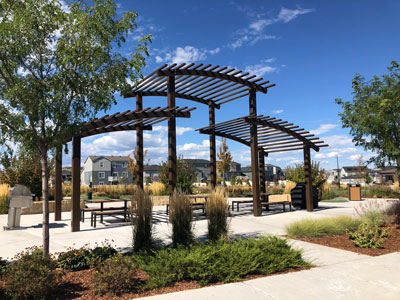
Pelak and Covington said that when collaborating with architects and clients, they “incorporate and draw inspiration from the local area.” This might include color, usage of unique materials and design elements such as curves. Laser-cut panels can have patterns and shapes added to offer a personal touch. “As this is done, other architects have seen what can be done, and that they’re not constrained to structures in a catalog. The design and manufacturing team enjoy working on creating something unique that hasn’t been done before.”
Scott Crawford is a principal with RDG Planning & Design, and he described how they master-plan entire park systems, plan specific parks and design all elements within parks, including shelters and shade structures, which he said are integral elements. “The location, size, amenities and architectural character of these structures can range dramatically depending on the context of the park and adjacent development to the park.
“Depending on the goals, objectives and funding for a specific park shelter,” continued Crawford, “we have the ability to design a one-of-a-kind shelter that is contextual to a specific park, neighborhood or community, or work with a shelter manufacturer to modify or customize a pre-engineered structure with elements that integrate well with the park context.” He said material selection and construction method are both informed by a number of factors, including intended uses, climate, costs, sustainability, desired aesthetic and targeted lifespan of the structure.
As far as aesthetics, it’s oftentimes not only a goal to blend in with other structures, but with the natural environment as well. “Parks are outdoor spaces that connect humans to nature. All elements of the built environment within parks are initially designed and constructed to integrate well with nature; in other words, vertical constructed elements in parks should seek to be harmonious with the natural environment of the park,” said Crawford.
Graves explained that their capabilities for customization allow for structures to be designed to coordinate or complement the surrounding environment. “Multiple structures can also be coordinated to be consistent throughout a facility to provide a more aesthetically pleasing look and feel.”
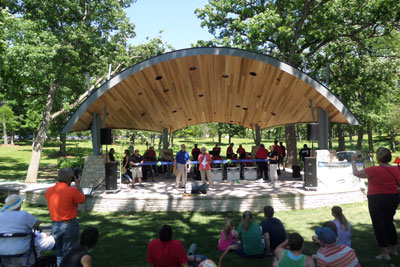
To suit site-specific requirements, she listed some decorative offerings, including laser-cut panels, ornamentation, column covers, end beam options, cupolas and materials such as artisan wood. Functional options include gliders, snow guards, gutters, electrical outlets, solar lighting, windscreens and integrated seating. Roof options include metal roofing, transparent roofing, decorative (laser-cut) roofing, shingles, trellis-style and fabric.
“Unless it’s a destination venue—like a band shell—we usually want (structures) to blend in with their context,” said Hornig. “Appropriate color choice and use of natural materials like stone and wood can help them match their setting.”
He said they commonly ask for modifications or customizations from general size, ornamentation, lighting and receptacles to complete fabrication of a custom idea or shape. “We also frequently add masonry wraps to the column bases.”
Lawrence pointed out that customization can be an easy and cost-effective way to tie in unique features from the site. This might include materials such as brick, stone, wood and metal, or key design elements such as inlays, roof pitch or arches—“historic features to make the shelter feel like it belongs or is complementary to the surrounding elements.”
She highlighted their Clarkson Park project in Northfield, Ill., as an example of blending a customized prefabricated structure with a local architect-designed shelter “on the same site in close proximity, and how we accomplished blending these two elements seamlessly into the site.”
She also mentioned their Campus Park project in Wisconsin, where “we used a pre-fab amphitheater structure with sound and lighting and built a custom designed CMU (concrete masonry unit) block construction restroom/concessions building, integrating it into a single structure.”
As far as trends, Graves mentioned the laser-cut panels, which are “designed to create unique shadows and dappled shade throughout the day. Laser-cut designs mimic the feeling of sitting under a tree, providing creative designs and shadows on the ground.”
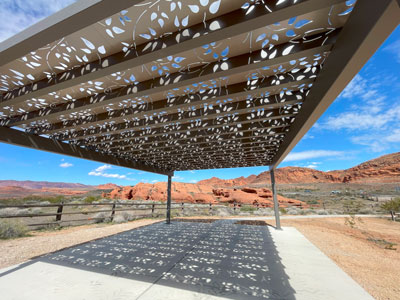
Pelak and Covington agreed that this was a trend, adding, “We have seen an increase in filtered light roof coverings incorporating laser-cut panels.”
In Elk Grove, Calif., the Elk Grove plaza added a
new pavilion last year to an area known for charming buildings, unique shops and local restaurants. The pavilion brings together residents and visitors alike. The interval structure features an L-shaped canopy, high ceilings and gable end ornamentation framed by wooden beams, and a custom-color roof, making the new structure blend seamlessly with the historic district.
“Often our shelters will be part of a larger master plan,” said Pelak and Covington, whose company completed the Elk Grove project. “In many cases, clients have used these structures to be a focal point for a community gathering space.” They said that this includes adding amphitheaters and band shells for people to watch performances, as well as being used for farmers markets or other larger events.
“Amphitheaters can be an eye-catching first impression and central hub within a park for hosting public events, concerts and performances,” said Graves, making them a focal point and destination. And she pointed out that through ticket admissions, amphitheaters can be a great resource to bring money back to a community or local charities. “With the ability to personalize a structure and increase site recognition with laser-cut medallions and signage, or by adding attachment points for temporary banners to identify sponsors and local events, the structure can serve a dual purpose as an advertisement for the park and its events.”
Hornig said that they’re seeing amphitheaters and larger structures added to community parks. “They come with infrastructure requirements like parking, electricity and sound that need to be considered, and add programming commitments that need to be thought through, but they can be great sources of community pride and celebration.”
Crawford agreed that spaces for community gathering and festivals continue to grow in popularity, and are often developed in parks. He said performance venues can range in size, amenities and design aesthetics to meet the program use needs of the facility. “While managing acoustics of outdoor venues is much more challenging than indoor concert halls, theatres or arenas, with appropriate planning, orientation and amplified sound considerations, outdoor performance venues can be designed to appropriately manage acoustics.”
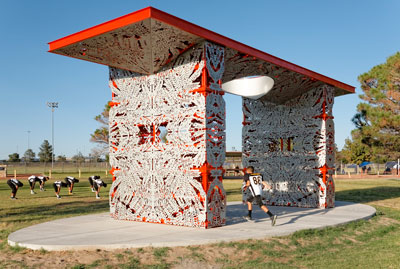
Lawrence mentioned a project where they’re working with an audio/visual firm to assist with designing a system for an outdoor amphitheater, and Hornig said they have included acoustic engineers in the past to evaluate sound direction and projection. “Many times it is less about the sound quality and more about being good neighbors to residents within range of a performance.”
Pelak and Covington explained that the roofing material plays a large part in acoustics, which is why tongue and groove is often used as roof decking. “We also will coordinate with the client to provide mounting or hanging points for sound equipment and lighting.” Features for hiding wires can also be incorporated into designs.
In addition to generating revenue through amphitheaters and other larger structures by hosting larger events, smaller shelters within parks are often available to be reserved by park users for a fee. “Pavilions can be rented out for family gatherings, birthday parties and company events,” said Graves. “The structures are low-maintenance and can bring in a constant revenue.”
In Illinois, the Chicago suburb of St. Charles has a robust parks system, and Erika Young, PR and marketing manager for the St. Charles Park District, tells us that their picnic pavilion rental program is very popular, “averaging 400 rentals per year from 12 pavilions across nine park locations.” She explained that most of the pavilions are custom builds by the district’s construction crew, though some are outsourced due to staff availability.
When it comes to materials, Young said the structures vary; in half the parks the structures are wooden, in the other half they are steel. “We also have some structures where we have worked to incorporate a green element such as a green roof or solar lighting. Most of the newly developed or recently renovated parks do have metal shelters with a color combination of posts and roofs that complement the area/housing/playground.”
All the shelters in the park system have a unique style that complements the park location, according to Young, such as the wooden River Pavilion which “is open on all sides to allow patrons to take in the relaxing calmness of the Fox River. In turn, you can go downtown to Mount St. Mary Park, which (features) a steel structure but has a striking look that complements the white riverfront railings, art sculptures and other hardscape. In each park location the pavilion spaces complement the atmosphere of the park in which they sit.”
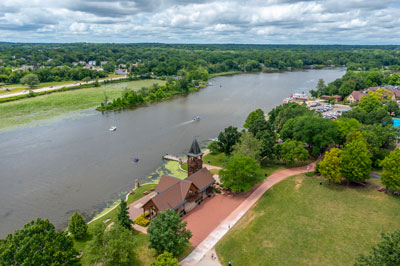
The park district has an in-house landscape architect and, depending on workloads, outside professionals are also utilized. And as park planners for the district, she explained that they also observe how people use outdoor spaces and where it makes sense to place an amenity like a shelter. “Where are people naturally gathering? Why? To get a better view of their children participating and playing? To be in an ideal spot to grab a child who elopes? Its distance from the roadway for peace and quiet?”
In Pottawatomie Park in St. Charles, a large pavilion constructed in 1892 included a tower, bridge and smaller pavilion. The majestic structure was removed in the 1950s due to deterioration, and a smaller pavilion for picnic rentals was built in the 1970s. But in 1999 it was removed to re-create the original structure. A local architectural firm provided research of the Victorian architecture, as well as design, drawings, specifications and oversight of the project at no cost. The pavilion and tower were built using modern building components encased in Victorian wood trim to reflect the original design; the gingerbread Douglas fir trim enhances the pavilion complex. After completion in 2001, fundraising continued until the historic tower could be built, opening in 2007.
At the St. Charles Park District’s waterpark, Young said the daily shade rentals are very popular, including cabanas, shade shells, suites and pavilions, “mostly because there are not a lot of trees on the property.”
And she said there’s been a trend in responses from community input opportunities asking for more shade. “We hear about the desire to be cooler in the summer, to make the playground equipment cooler as well as concerns about the cumulative exposure to UV rays and risk of melanoma.” She mentioned several parks and sports complexes—including both passive spaces and ballfields—where they’ve added shade in recent years, with several more projects upcoming.
Crawford said that providing shade opportunities is becoming increasingly important in parks, through natural elements and the built environment, “especially as global temperatures continue to rise and given what we know about how overexposure to UV rays can lead to increased health risks.”
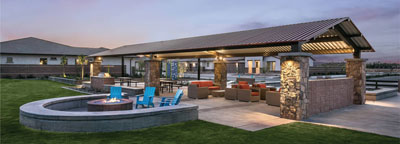
Hornig agreed that “Shade is a big deal as a reduction strategy for skin cancer related to sun exposure.” He said they like to see shade over dugouts and added that there are more requests for shade over playground areas, though cost does impact these projects. “There are several agencies that offer grants to help fund shade in play environments.”
Hornig also pointed out that visually, park shelters tend to be more traditional in style while “shade structures tend to lend themselves to more modern designs.”
Fabric shade structures showcase an “artsy” flair, and Graves said their fabric structures “offer a creative yet practical solution for adding shade to different environments such as waterparks, amusement parks, playgrounds and dining areas. Because of its durability and flexibility, fabric can be used in a variety of applications providing an affordable option for sun protection.” She added that fabric structures can keep seats cooler while providing a fun aesthetic, offering a variety of colors and design styles.
Crawford said that oftentimes in parks, a shelter will serve as the primary gathering space for visitors, “providing an outdoor covered area for seating, activities, restrooms, drinking fountains, bicycle parking, charging stations for mobile devices, signage and wayfinding, park information and support for other uses within the park.”
Added Graves, “Farmers markets can be developed for a permanent venue so merchants no longer have to transport tents. Parks are adding fitness equipment and interactive games that need protection from the elements. Playgrounds and splash pads are incorporating shade to allow children to play longer without the fear of overexposure to direct sunlight while preventing equipment from getting too hot. Even dog parks need a place for pets and owners alike to stop and take a break.” RM


